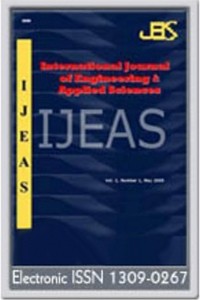Numerical Analysis of Single Lap Pretension Bolted Joint
Numerical Analysis of Single Lap Pretension Bolted Joint
Due to their superiority, bolted connections are commonly utilized to join numerous building components. When evaluating the impacts of the connections on the behavior and load-bearing capacity of structural systems, it is crucial to understand the parameters that govern the load-carrying capacity of bolted joints. The bearing capacity of single lap and single bolt friction-effect joints are examined numerically in this paper. Through numerical analysis, the variation in the bearing capacity of the joint as a function of the parameters affecting joint capacity, the pre-tension force, and the surface friction coefficient between the joining plates, was analyzed. Accordingly, it has been observed that the pre-tensioning force and friction coefficient both increase the joint's capacity in a comparable manner. The results demonstrate that the bearing capacity of a slip-critical joint can be enhanced by applying roughening techniques to the friction surfaces of the plate.
___
- Ministry of Environment and Urbanisation, Specification for Design and Construction of Steel Structures, Republic of Turkey Ministry of Environment and Urbanisation, Ankara,Turkey, 2016.
- Sudev, L.J. and Gajendra, S., Strength analysis of single lap dissimilar materials bolted joint. In IOP Conference Series: Materials Science and Engineering, 390(1), 2018.
- Riccio, A., Effects of geometrical and material features on damage onset and propagation in single-lap bolted composite joints under tensile load: part ii–numerical studies. Journal of Composite Materials, 39(23), 2091-2112, 2005.
- Da Silva, L.F., Rodrigues, T.N.S.S., Figueiredo, M.A.V., De Moura, M.F.S.F., Chousal, J.A.G., Effect of adhesive type and thickness on the lap shear strength. The Journal of Adhesion, 82(11), 1091-1115, 2006.
- Ireman, T., Three-dimensional stress analysis of bolted single-lap composite joints. Composite Structures, 43(3), 195-216, 1998.
- Sinthusiri, C. and Nassar, S.A., Load Distributions in Bolted Single Lap Joints Under Non-Central Tensile Shear Loading. Journal of Advanced Joining Processes, 3, 2021.
- McCarthy, C.T. and McCarthy, M.A., Three-dimensional finite element analysis of single-bolt, single-lap composite bolted joints: Part II––effects of bolt-hole clearance. Composite Structures, 71(2), 159-175, 2005.
- Saraç, İ., The numerical investigation of the effects of hole tolerance and bolt torque variation on the joint strength in the bolted joints. Journal of the Faculty of Engineering and Architecture of Gazi University, 37(2), 685-695, 2022.
- Ghanbari, E., Sayman, O., Ozen, M., Arman, Y., Failure load of composite single-lap bolting joint under traction force and bending moment. Australian Journal of Basic and Applied Sciences, 6(9), 683-692, 2012.
- Chakherlou, T.N. and Jirandehi, A.P., A profound study on the effects of friction coefficient on torque tightened, longitudinally loaded, bolted connections. The 1st conference on Modern Achievements in Aerospace and Related Sciences, Tehran, Iran, 2015.
- Khashaba, U.A., Sallam, H.E.M., Al-Shorbagy, A.E., Seif, M.A., Effect of washer size and tightening torque on the performance of bolted joints in composite structures. Composite Structures, 73(3), 310-317, 2006.
- Varma, A, Design of Steel Structures Lecture Notes. https://www.egr.msu.edu/~harichan/classes/ce405/chap5.pdf, 2002.
- Liu, W. and Lin, W., Stress around the hole of single lapped and single bolted joint plates with fitting clearance. Journal of Mechanical Science and Technology, 33(4), 1623-1632, 2019.
- Liu, L., Mao, Y., Wei, R., An analytical tool to predict load distribution of multi-bolt single-lap thick laminate joints. In Proceedings of the 18th International Conference on Composite Materials, Korea, 2011.
- Pawar, J.S., Chouksey, M., Tripathi, K., Modeling and stress analysis of single lap bolted joint. Universal Journal of Mechanical Engineering, 3(1), 21-26, 2015.
- Kohnke, P., Theory reference for the mechanical APDL and mechanical applications, Ansys, Inc, Canonsburg, 2009.
- Başlangıç: 2009
- Yayıncı: Akdeniz Üniversitesi
